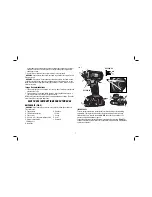
8
To install the battery pack (F) into the tool handle, align the battery pack with the rails
inside the tool’s handle and slide it into the handle until the battery pack is firmly
seated in the tool and ensure that it does not disengage.
To remove the battery pack from the tool, press the release button (E) and firmly pull
the battery pack out of the tool handle. Insert it into the charger as described in the
charger section of this manual.
FUEL GAUGE BATTERY PACKS (FIG. 3A)
Some D
E
WALT battery packs include a fuel gauge which consists of three green LED
lights that indicate the level of charge remaining in the battery pack.
To actuate the fuel gauge, press and hold the fuel gauge button (K). A combination
of the three green LED lights will illuminate designating the level of charge left. When
the level of charge in the battery is below the usable limit, the fuel gauge will not
illuminate and the battery will need to be recharged.
K
FIG. 3A
NOTE:
The fuel gauge is only an indication of the charge left on the battery pack.
It does not indicate tool functionality and is subject to variation based on product
components, temperature and end-user application.
For more information regarding fuel gauge battery packs, please contact Stanley Black
& Decker, 82 Taryn Drive, Epping, VIC 3076 Australia or call 1800 444 224 or (NZ).
0800 339 258.
Variable Speed Trigger Switch (Fig. 2)
To turn the tool on, squeeze the trigger switch (A). To turn the tool off, release the
trigger switch. Your tool is equipped with a brake. The chuck will stop when the trigger
switch is fully released. The variable speed switch enables you to select the best
speed for a particular application. The more you squeeze the trigger, the faster the
tool will operate. For maximum tool life, use variable speed only for starting holes or
fasteners.
Belt Hook and Bit Clip (Fig. 2)
WARNING: To reduce the risk of serious personal injury, turn tool off and
disconnect battery pack before making any adjustments or removing/installing
attachments or accessories.
WARNING: To reduce the risk of serious personal injury, DO NOT
suspend tool
overhead or suspend objects from the belt hook.
ONLY
hang tool’s belt hook from a
work belt.
WARNING: To reduce the risk of serious personal injury, ensure the screw
holding the belt hook is secure.
IMPORTANT:
When attaching or replacing the belt hook or bit clip, use only the screw
(I) that is provided. Be sure to securely tighten the screw.
The belt hook (H) and bit clip (J) can be be attached to either side of the tool using
only the screw (I) provided, to accommodate left- or right- handed users. If the hook
or bit clip is not desired at all, it can be removed from the tool.
To move belt hook or bit clip, remove the screw (I) that holds it in place then
reassemble on the opposite side. Be sure to securely tighten the screw.
OPERATION
WARNING: To reduce the risk of serious personal injury, turn tool off and
disconnect tool from power source before making any adjustments or removing/
installing attachments or accessories.
Installing and Removing the Battery Pack (Fig. 3)
NOTE:
For best results, make sure your battery pack is fully charged.
F
E
FIG. 3


































